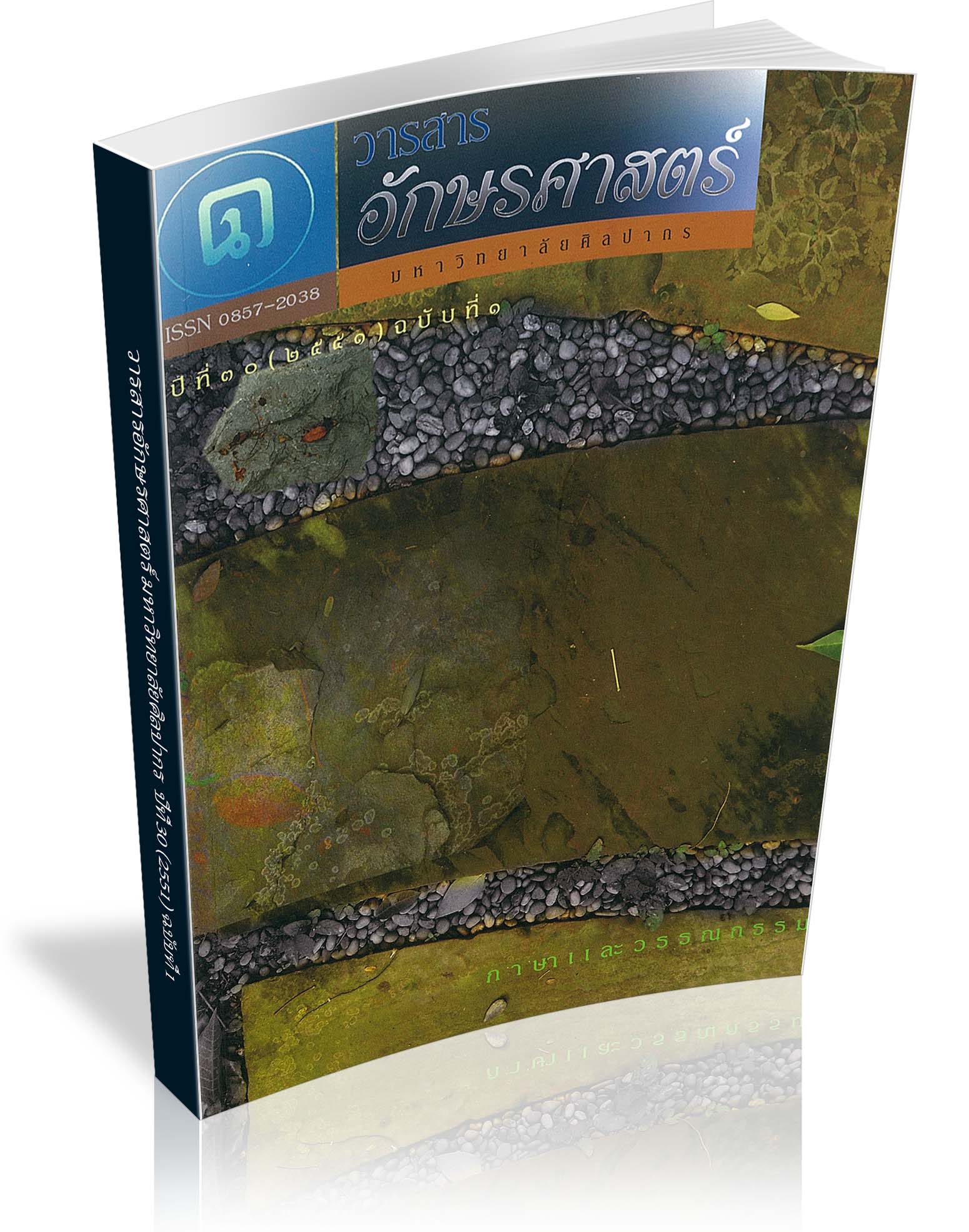Figures of Speech in Feature Stories in Reader's Digest
Keywords:
การใช้ภาพพจน์, สารคดีAbstract
This research paper studies figures of speech which appear in feature stories and their characteristics, comparing vocabulary and idioms in different types of features as well as collecting general information on figures of speech, vocabulary and idioms in feature stories published in Reader's Digest.
The results are as follows:
- Analysis of the titles of the feature stories published in Reader's Digest reveals that 50% of them use figures of speech and 26.67% of alliteration, 23.33% of pun, 21.11% of metaphor, 12.22% of graveyard, 11.11% of assonance, 4.44% of irony, 1.11% of repetition are employed respectively. The figures of speech which appear in the titles of the feature stories, 87.22% are written in phrases.
Analysis of the feature stories in Reader's Digest reveals that 37.58% of metaphor, 13.03% of simile, 10.30% of metonymy, 7.58% of onomatopoeia, 6.06% of irony, 5.30% of repetition, 4.85% of alliteration, 4.24% of pun, 3.03% of rhetoric question, 2.73% of hyperbole, 2.12% of graveyard, 1.52% of litotes, 0.91% of assonance, 0.45% of synecdoche and 0.30% of oxymoron are employed respectively.
- Reader's Digest publishes all types of feature stories; namely informative features (18.33%), How-to features (18.33%), personality or profile features (17.78%), personal experience features (16.11%), enterprise features (12.78%), descriptive features (9.44%), news features (6.11%) and historical features (1.11%).
- The comparison of Reader's Digest features reveals that the writers employ informal language and idioms differently. The use of informal language appears mostly in personality or profile features (32.08%) followed by enterprise features (18.87%), personal experience features (16.98%), How-to features (13.21%), informative features (11.32%), news features (3.77%) and descriptive features (3.77%) respectively. Informal language is not employed in historical features.
Analysis of idioms employed in different types of Reader's Digest features reveals that the use of idioms appears mostly in personality or profile features (30.77%) followed by informative features (19.23%), How-to features (19.23%), personal experience features (15.38%), enterprise features (7.69%), news features (3.85%) and descriptive features (3.85%) respectively. Idioms are not employed in historical features.
- Analysis of general information of figures of speech, vocabulary and idioms in feature stories published in Reader's Digest reveals that the writers use the following literary styles :
4.1 direct use of figures of speech in statements
4.2 language that implies a good sense of humour, in order to make the features colourful and appealing to readers
4.3 language that is impressive and sensational
4.4 proverbial expressions
4.5 satirical literary style
Downloads
References
พิศิษฐ ชวาลาธวัช. การรายงานข่าวชั้นสูง. กรุงเทพมหานคร : ดอกหญ้า, ๒๕๔๐.
ภรณี ธำรงสัตย์. ภาษาอังกฤษในหนังสือพิมพ์. คณะอักษรศาสตร์ มหาวิทยาลัยศิลปากร, ๒๕๒๘.
รัชนี ซอโสติกุล. สำนวนอังกฤษ-สำนวนไทย. กรุงเทพมหานคร : จุฬาลงกรณ์มหาวิทยาลัย, ๒๕๓๗.
ราชบัณฑิตยสถาน. พจนานุกรมศัพท์วรรณกรรม. กรุงเทพมหานคร : ราชบัณฑิตยสถาน, ๒๕๔๕.
Barbara C., Palmer and Mary Alice Brooks. “Reading until the cows come home : Figurative language and reading comprehension.” Journal of Adolescent and Adult Literacy 47, 5 ( February 2004 ) : 370–379.
Baddock, Barry. Scoop! Oxford : Perganon, 1984.
Bartel, Joan Corliss. The Metropolitan Daily News : Understanding American Newspaper. New Jersey : Regents / Prentice Hall, 1994.
แหล่งข้อมูล
Reader's Digest. January, 2005 - December, 2005
Time
Bangkok Post
The Nation
www.english.unitechnology.ac.nz
www.en.wikepedia.org
www.efl.htmlplanet.com
www.findarticles.com
www.hps.com
www.newyorktimes.com
www.Thetimes.co.uk
www.USA. Today.com
Downloads
Published
How to Cite
Issue
Section
License
ผู้เขียนบทความต้องยินยอมในข้อกำหนดต่าง ๆ ของวารสารก่อนส่งบทความตีพิมพ์




